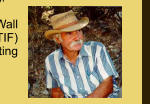
WALL STREET JOURNAL AWARD and INTERVIEW
In
2007,
the
Wall
Street
Journal
recognized
the
importance
of
land
imprinting
by
selecting
The
Imprinting
Foundation
for
an
Innovation
Award
presented
at
a
conference
in
Redwood, California (Wall Street Journal 2007).
The
series
of
award
application
questions
asked
by
the
Wall
Street
Journal
(WSJ)
and
The
Imprinting
Foundation
(TIF)
responses
briefly
summarize
the
development
of
land
imprinting
during
the
past 30 years. This series follows:




•
WSJ: What, briefly, is your innovation?
TIF
:
Land
imprinting
is
a
new
method
and
machine
that
is
directed
to
reversing
the
world's
number
one
environmental
problem:
land
desertification or degradation (also global warming).
•
WSJ: What is the current situation in the field in which your innovation appears?
TIF:
Land
imprinting
has
already
restored
vegetation
on
more
than
40,000
hectares
(100
thousand
acres)
of
degraded
land
in
the
Desert
Southwest
where
it's
the
only
method
that
always
works.
But
where
imprinting
has
to
compete
with
the
well
institutionalized
seed drills in more humid regions, the new idea has been difficult to introduce.
•
WSJ: What is the problem with this situation that your innovation is seeking to address?
TIF:
Land
imprinting
reverses
global
land
desertification,
land
degradation,
and
global
warming
by
restoring
the
hydrological
properties
of
the
soil
surface-micro-roughness
and
macro-porosity-to
rehydrate
the
degraded
soil
for
vegetation
establishment
and
atmospheric
CO 2 reduction.
•
WSJ: How does your innovation address this situation?
TIF
:
Land
imprinters
wedge
one-foot-square,
V-shaped,
closed
micro-watersheds
into
the
degraded
soil
surface
that
funnel
rainwater,
seeds,
plant
litter,
and
splash-eroded
soil
together
where
they
can
work
in
concert
to
germinate
seeds,
establish
seedlings
and
grow
plants. Thus, the success of imprints in re-vegetation projects is because of the superior management of water at the soil surface.
•
WSJ: What is particularly novel or noteworthy about your innovation?
TIF
:
Land
imprinting
wedges
seedbeds
into
the
degraded
surface
without
soil
surface
inversion.
Each
imprint
is
a
closed
micro-
watershed
that
can
hold
a
gallon
of
water
that,
in
turn,
increases
water
infiltration
at
least
ten-fold.
Imprinting
is
unexcelled
in
soil
and
water conservation for ensuring success of re-vegetation projects.
To email us, click on logo to left


WALL STREET JOURNAL AWARD and INTERVIEW
In
2007,
the
Wall
Street
Journal
recognized
the
importance
of
land
imprinting
by
selecting
The
Imprinting
Foundation
for
an
Innovation
Award
presented
at
a
conference in Redwood, California (Wall Street Journal 2007).
The
series
of
award
application
questions
asked
by
the
Wall
Street
Journal
(WSJ)
and
The
Imprinting
Foundation
(TIF)
responses
briefly
summarize
the
development
of
land
imprinting
during the past 30 years. This series follows:

Imprinting Foundation
•
WSJ: What, briefly, is your innovation?
TIF
:
Land
imprinting
is
a
new
method
and
machine
that
is
directed
to
reversing
the
world's
number
one
environmental
problem:
land
desertification
or
degradation
(also
global warming).
•
WSJ: What is the current situation in the field in which your innovation appears?
TIF:
Land
imprinting
has
already
restored
vegetation
on
more
than
40,000
hectares
(100
thousand
acres)
of
degraded
land
in
the
Desert
Southwest
where
it's
the
only
method
that
always
works.
But
where
imprinting
has
to
compete
with
the
well
institutionalized
seed
drills
in
more
humid
regions,
the
new
idea
has
been
difficult
to
introduce.
•
WSJ:
What
is
the
problem
with
this
situation
that
your
innovation
is
seeking
to
address?
TIF:
Land
imprinting
reverses
global
land
desertification,
land
degradation,
and
global
warming
by
restoring
the
hydrological
properties
of
the
soil
surface-micro-
roughness
and
macro-porosity-to
rehydrate
the
degraded
soil
for
vegetation
establishment and atmospheric CO 2 reduction.
•
WSJ: How does your innovation address this situation?
TIF
:
Land
imprinters
wedge
one-foot-square,
V-shaped,
closed
micro-watersheds
into
the
degraded
soil
surface
that
funnel
rainwater,
seeds,
plant
litter,
and
splash-
eroded
soil
together
where
they
can
work
in
concert
to
germinate
seeds,
establish
seedlings
and
grow
plants.
Thus,
the
success
of
imprints
in
re-vegetation
projects
is
because of the superior management of water at the soil surface.
•
WSJ: What is particularly novel or noteworthy about your innovation?
TIF
:
Land
imprinting
wedges
seedbeds
into
the
degraded
surface
without
soil
surface
inversion.
Each
imprint
is
a
closed
micro-watershed
that
can
hold
a
gallon
of
water
that,
in
turn,
increases
water
infiltration
at
least
ten-fold.
Imprinting
is
unexcelled
in
soil
and
water
conservation
for
ensuring
success
of
re-vegetation
projects.
Email Web Mistress
To email us, click on
logo to left






















































